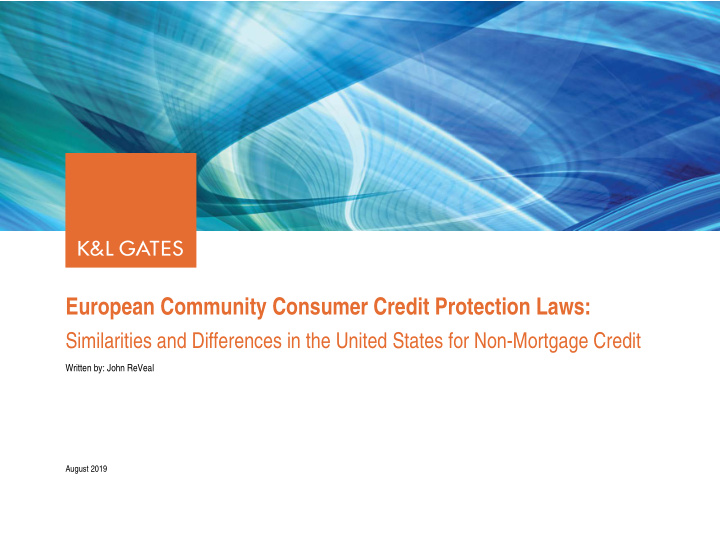



European Community Consumer Credit Protection Laws: Similarities and Differences in the United States for Non-Mortgage Credit Written by: John ReVeal August 2019
TABLE OF CONTENTS Scope ........................................................................................................................... 4 Pre-Contractual Disclosures ....................................................................................... 9 Credit Agreement Disclosures .................................................................................. 10 Overrunning Disclosures .......................................................................................... 12 Annual Percentage Rates .......................................................................................... 12 Interest Rate Changes ............................................................................................... 14 Other Changes in Terms ........................................................................................... 15 Ability to Repay Analysis .......................................................................................... 15 Right of Withdrawal ................................................................................................... 16 Termination of Open-End Credit Agreements ......................................................... 18 Periodic Statements .................................................................................................. 19 Prepayment Penalties ................................................................................................ 19 Penalties ..................................................................................................................... 20 Assignee Liability ...................................................................................................... 20 Credit Report Adverse Action Notices ..................................................................... 21 Advertising Disclosures ............................................................................................ 21 Linked Credit Agreements ........................................................................................ 22 Certain Additional TILA Rules ................................................................................... 23 Contacts ..................................................................................................................... 26
European Community Consumer Credit Protection Laws: Similarities and Differences in the United States for Non-Mortgage Credit by John ReVeal Financial institutions that operate only in the United States (US) or only in the European Union (EU) might be excused for believing that they face unreasonable burdens under local consumer credit protection laws. Broadly speaking, however, the US and EU consumer credit protection laws share many similarities and policy perspectives. This is by no means to suggest that their respective laws are identical, and the nature of the EU means that there will be certain differences among the Member States -- just as there will be differences among the various States within the US. This article compares the basic consumer protections for non-mortgage credit under EU directives to the consumer protections under US federal law. The aim of this summary is to provide only a very high level comparison. Many details, and perhaps very important details, are omitted. We do not attempt to address the rules that the individual States within the US, or the rules that individual Member States within the EU, might have enacted. We also focus on subjects relating primarily to the lending activity itself. As a preliminary note, both the EU and US have laws that require a bank charter or license for entities that offer lending products or loans to consumers. While such charters/licenses are also outside the scope of this article, it is worth noting that, in both locations, a chartered bank (or “credit institution,” in the EU) is permitted to offer its services across all applicable jurisdictions (although sometimes requiring local approvals), either through interstate banking laws in the US or through “passporting” in the EU. However, the similarities end there because, non-bank lenders licensed in one State in the US have no passporting rights and must obtain the appropriate local credit license in each State in which its customers/debtors are located. The Respective Legal Systems A complete summary of the EU legal system is far beyond the scope of this article, but a few general comments might be helpful for the boarder understanding of this comparison of consumer protection laws. The two main sources of EU law are the EU treaties, referred to as the primary law, and the secondary law consisting of legal instruments based on those treaties, such as regulations, directives, decisions and agreements. This article focuses on certain directives. A "directive" is a legislative act that sets out a goal that all EU countries must achieve within a set time frame, but it is up to the individual countries to devise their own laws and 1
regulations to reach these goals. 1 Directives therefore generally are less specific than “regulations,” which are binding legislative acts that must be applied directly in their entirety across the EU. The US legal system is comparable to the EU system in that there are federal laws and regulations that apply in every State of the US, but each State is free to enact its own additional laws and regulations. The laws and regulations of the various States within the US generally cannot be inconsistent with federal law or the particular application of that federal law, but States are usually empowered to enact laws that are more protective of consumers. Some of the key EU directives and related materials impacting non-mortgage consumer credit are: • Directive 2008/48/EC on credit agreements for consumers, issued 23 April 2008 (“Consumer Credit Directive” or “CCD”) • Guidelines on the application of the Consumer Credit Directive in relation to costs and the Annual Percentage Rate of Charge, issued 8 May 2012 (“APR Guidance”) • Directive 2002/65/EC concerning distance marketing of consumer financial services (“Distance Marketing Directive”) Because each Member State is required to adopt a transposing act or national implementing measure to transpose each directive to national law, the national law adopted by one Member State may differ from that adopted by other Member States. Those differences, however, are generally relatively minor and it is therefore useful to compare the goals set forth in the applicable directives to the federal consumer protection laws of the US. The primary federal consumer protection laws in the US relating to non-mortgage credit are the Truth in Lending Act (“TILA”), Fair Credit Reporting Act (“FCRA”), Equal Credit Opportunity Act (“ECOA”), Electronic Fund Transfers Act (“EFTA”), and the “holder rule” of the Federal Trade Commission (“FTC”). Except for the FTC’s holder rule, each of these laws is implemented through regulations, which include a majority of the important details. It therefore is important not to focus on the statutes to the exclusion of the regulations. While the same might be said of the EU directives given that each Member State must enact its own laws or regulations to transpose each directive, and those Member States rules can be more detailed than the various directives, we are not attempting in this article to address the laws or regulations that any Member State has actually enacted to implement any directive. Nevertheless, we hope that the reader will find the summaries to provide an informative guide to the broad differences and similarities between EU consumer credit protection law and the federal laws of the US relating to consumer credit. 1 European Union Regulations, Directives and other acts: https://europa.eu/european-union/eu-law/legal-acts_en 2
Recommend
More recommend